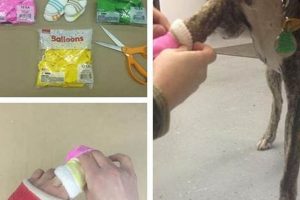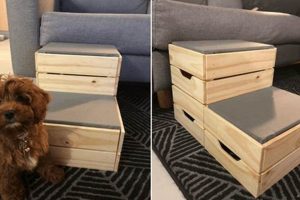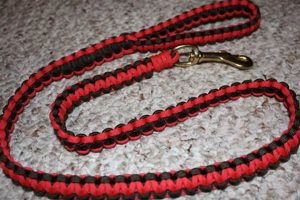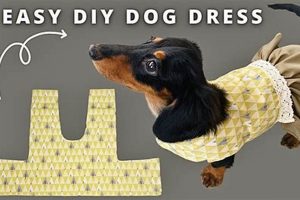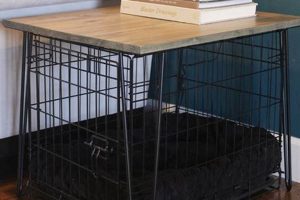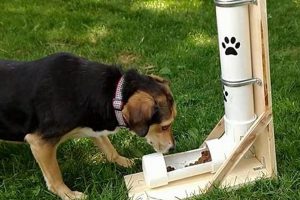A homemade anxiety wrap for canines represents a cost-effective alternative to commercially available products designed to alleviate stress and fear in dogs. These homemade versions mimic the swaddling effect of a manufactured product, applying gentle, constant pressure to a dog’s torso, which has been shown to have a calming effect on some animals experiencing anxiety triggers such as thunderstorms, fireworks, or travel.
The primary advantage of creating such an item is cost savings, as readily available materials such as fabric scraps and hook-and-loop fasteners can be utilized. Furthermore, crafting a custom version allows for tailoring the fit and design to the specific needs and preferences of the individual dog. Anecdotal evidence suggests that the consistent, comforting pressure provides a sense of security, leading to a reduction in anxious behaviors like panting, shaking, and hiding. The history of using pressure to calm animals extends back to agricultural practices and has found more modern application in companion animal care.
Subsequent sections will detail the step-by-step construction of these canine anxiety wraps, including material selection, measurement techniques, and fitting guidelines. Best practices for introducing the wrap to the dog and monitoring its response will also be discussed.
Tips for Creating Effective Canine Anxiety Wraps
The following suggestions are provided to optimize the construction and utilization of homemade canine anxiety wraps, promoting both effectiveness and animal comfort.
Tip 1: Material Selection is Paramount: Opt for soft, breathable, and slightly stretchy fabrics. Fleece, flannel, or knit materials minimize skin irritation and allow for comfortable movement while still providing consistent pressure. Avoid stiff or scratchy fabrics that may cause discomfort.
Tip 2: Accurate Measurement is Essential: Measure the dog’s chest circumference directly behind the front legs. This measurement dictates the primary body piece length. Ensure the wrap provides snug, but not restrictive, coverage.
Tip 3: Closure System Considerations: Hook-and-loop fasteners offer adjustability for optimal pressure. Ensure the fasteners are securely sewn and positioned to avoid direct contact with the dog’s skin, preventing chafing or irritation.
Tip 4: Gradual Introduction is Recommended: Do not immediately apply the wrap for extended periods. Begin with short sessions (5-10 minutes) and gradually increase the duration as the dog acclimates. Positive reinforcement, such as treats or praise, can help associate the wrap with positive experiences.
Tip 5: Monitor the Dog’s Response Closely: Observe the dog for signs of discomfort, such as excessive panting, scratching, or attempts to remove the wrap. Adjust the fit or discontinue use if any adverse reactions are noted.
Tip 6: Regular Cleaning is Necessary: Wash the wrap regularly according to the fabric’s care instructions. A clean wrap minimizes the risk of skin irritation and maintains hygiene.
Tip 7: Supervise Initial Use: During the initial uses, supervise the dog to ensure it does not chew or attempt to destroy the wrap. This prevents ingestion of materials and potential choking hazards.
These tips emphasize the importance of careful planning, precise execution, and consistent monitoring when creating and utilizing a homemade canine anxiety wrap. Success hinges on prioritizing the dog’s comfort and well-being.
The subsequent section will address potential limitations and alternative solutions for managing canine anxiety.
1. Fabric
The selection of fabric is a foundational element in the creation of a homemade canine anxiety wrap. The chosen material directly impacts the garment’s comfort, effectiveness, and durability. The following facets outline critical considerations regarding fabric choice.
- Breathability and Comfort
Fabric breathability is crucial to prevent overheating and skin irritation, especially during extended use. Natural fibers like cotton or bamboo blends offer superior breathability compared to synthetic materials. The fabric should also be soft and non-abrasive to avoid chafing or discomfort. For instance, a fleece wrap may be comfortable in cooler temperatures but could lead to overheating in warmer climates, negating any potential anxiety-reducing benefits.
- Stretch and Conformance
A slight degree of stretch allows the wrap to conform to the dog’s body without restricting movement. Knit fabrics or those with spandex content provide this flexibility. A fabric that is too rigid may create pressure points or hinder the dog’s natural gait. The ability to stretch slightly ensures a snug, yet comfortable, fit that distributes pressure evenly.
- Durability and Washability
The fabric should withstand repeated use and washing without significant degradation. Durable materials like canvas or denim offer longevity but may sacrifice comfort. A balance between durability and comfort is often achieved with tightly woven cotton or polyester blends. Furthermore, the fabric should be machine washable for ease of care.
- Hypoallergenic Properties
For dogs with sensitive skin or allergies, hypoallergenic fabrics are essential. Organic cotton or bamboo fabrics minimize the risk of allergic reactions. Avoid fabrics treated with harsh chemicals or dyes that may irritate the dog’s skin. Choosing a hypoallergenic fabric can prevent secondary issues that may exacerbate anxiety.
In summary, fabric selection for a homemade canine anxiety wrap requires careful consideration of breathability, stretch, durability, and hypoallergenic properties. The optimal choice balances these factors to ensure the garment is both effective in reducing anxiety and comfortable for the dog to wear.
2. Fit
The fit of a homemade canine anxiety wrap directly influences its effectiveness. An improperly fitted wrap may fail to provide the consistent, gentle pressure necessary to elicit a calming effect. Conversely, a wrap that is too tight can cause discomfort, restrict movement, and exacerbate anxiety. Therefore, accurate measurement and careful adjustment are paramount to successful implementation.
A wrap that is too loose will not exert the intended pressure, rendering it ineffective. Imagine a dog exhibiting anxiety during a thunderstorm; if the wrap does not provide a snug embrace, the dog may not experience the intended sense of security. In contrast, a wrap that constricts the chest can impede breathing or cause chafing, leading to increased distress and potentially triggering a negative association with the garment. Achieving the correct fit requires precise measurement of the dog’s chest circumference and careful consideration of the wrap’s design. Adjustable closures, such as hook-and-loop fasteners, allow for fine-tuning the fit to accommodate variations in body shape and size.
Ultimately, the optimal fit is one that provides a snug, comfortable, and consistent pressure across the dog’s torso without restricting movement or causing discomfort. Consistent monitoring and adjustment are crucial to ensure the wrap remains effective and comfortable over time. Proper fit ensures the homemade wrap provides the intended therapeutic benefit, contributing to a reduction in anxiety symptoms. Failure to prioritize fit can negate any potential benefits and potentially worsen the dog’s anxiety.
3. Pressure
The application of consistent, gentle pressure is the fundamental mechanism by which a homemade canine anxiety wrap achieves its purported calming effect. The design and construction of these wraps directly aims to replicate the swaddling or comforting sensation that can alleviate anxiety symptoms in some dogs. Improperly calibrated or unevenly distributed pressure may render the device ineffective or even counterproductive. The principle is based on the theory that consistent pressure can modulate the nervous system, promoting a sense of security and reducing the physiological manifestations of anxiety. For instance, a dog exhibiting signs of fear during a thunderstorm might experience a reduction in panting, shaking, and hiding behaviors when wearing a correctly fitted wrap that provides this even pressure.
The construction of an effective canine anxiety wrap must therefore prioritize the uniform distribution of pressure across the dog’s torso. The selected materials, closure mechanisms, and overall design should contribute to this goal. For example, wide straps secured with hook-and-loop fasteners allow for adjustable and customizable pressure. The placement of these straps should be carefully considered to avoid creating pressure points or restricting movement. The fabric should also exhibit a degree of elasticity to maintain consistent pressure as the dog moves. The practical significance of understanding this lies in the ability to tailor the design and construction of the wrap to the individual dog’s needs, maximizing its therapeutic potential.
In conclusion, the successful utilization of a homemade canine anxiety wrap hinges on the effective and uniform application of pressure. Careful consideration of material selection, design, and fit is essential to achieve this goal. Challenges remain in objectively quantifying the optimal pressure level for individual dogs, highlighting the need for careful observation and adjustment during initial use. However, by understanding the underlying mechanism of action and adhering to best practices in construction and fitting, individuals can create a cost-effective and potentially beneficial tool for managing canine anxiety.
4. Closure
The closure mechanism on a homemade canine anxiety wrap is a critical component influencing the garment’s fit, pressure distribution, and overall effectiveness. A poorly designed or implemented closure can compromise the wrap’s ability to provide consistent, gentle pressure, thereby negating its intended calming effect. The following facets delineate key considerations for closure design.
- Adjustability and Customization
The closure should allow for adjustability to accommodate variations in a dog’s body shape and size. Hook-and-loop fasteners, such as Velcro, offer a wide range of adjustability and are relatively easy to use. This feature is particularly important as dogs’ sizes can fluctuate, and the wrap’s effectiveness relies on a snug, customized fit. For instance, a wrap designed for a deep-chested breed may require multiple adjustment points to ensure even pressure distribution. Without adjustability, the wrap may be too loose in some areas and too tight in others, rendering it ineffective and potentially uncomfortable.
- Security and Stability
The closure must remain securely fastened during the dog’s movement to maintain consistent pressure. Weak or unreliable closures may come undone, disrupting the calming effect and potentially startling the dog. Durable hook-and-loop fasteners or sturdy buckles are suitable options. Reinforcing the closure with additional stitching can enhance its security. An example would be using heavy-duty, industrial-strength hook-and-loop fasteners designed for repeated use and exposure to stress. Failure of the closure could lead to the dog disliking or fearing the wrap, undoing any previous positive associations.
- Placement and Comfort
The placement of the closure is crucial to prevent rubbing or irritation against the dog’s skin. Closures positioned near sensitive areas, such as the armpits or groin, can cause discomfort and lead to skin abrasions. Positioning the closure along the back or chest, with a fabric buffer between the fastener and the skin, minimizes this risk. Consider a design that incorporates a wide, soft fabric panel underneath the closure to protect the dog’s skin. Improper placement of the closure can not only cause physical discomfort but also create a negative association with the wrap, making it difficult to use consistently.
- Ease of Use
The closure should be easy to fasten and unfasten, particularly for individuals with limited dexterity or mobility. Complex or difficult-to-manipulate closures can discourage consistent use. Simple hook-and-loop fasteners or quick-release buckles are often the most user-friendly options. For example, large, easily grasped tabs on hook-and-loop closures can facilitate easier fastening. If the closure is cumbersome or requires significant effort, the likelihood of the wrap being used consistently decreases, thereby diminishing its potential benefits.
In conclusion, the closure mechanism is an integral aspect of a homemade canine anxiety wrap, influencing its adjustability, security, comfort, and ease of use. A well-designed closure contributes significantly to the wrap’s effectiveness in providing consistent, gentle pressure, ultimately promoting a sense of security and reducing anxiety symptoms in the dog.
5. Introduction
The initial introduction of a homemade canine anxiety wrap to a dog is a critical determinant of its long-term success. This initial interaction shapes the dog’s perception of the garment, influencing its willingness to wear it and, consequently, the wrap’s potential efficacy. A negative introduction can lead to aversion, rendering the wrap unusable and potentially exacerbating the dog’s anxiety. Conversely, a carefully managed and positive introduction can foster acceptance and promote the wrap’s association with positive experiences, maximizing its calming effects. A poorly executed introduction might involve forcing the wrap onto the dog, causing fear and resistance. In contrast, a successful introduction would involve gradual exposure, positive reinforcement, and careful monitoring of the dog’s reactions.
The introduction process should prioritize the dog’s comfort and sense of security. This can be achieved through several strategies. First, allowing the dog to investigate the wrap freely can reduce initial apprehension. Next, associating the wrap with positive reinforcement, such as treats or praise, can create a positive association. Third, short, supervised sessions, gradually increasing in duration, allow the dog to acclimate to the sensation of wearing the wrap. Furthermore, observing the dog’s body language for signs of discomfort or anxiety is crucial. If the dog exhibits signs of distress, the introduction process should be slowed down or modified. For example, a dog that initially pulls away from the wrap might benefit from simply having it nearby during feeding or playtime. Over time, the dog may begin to associate the wrap with positive experiences, increasing its willingness to wear it.
In conclusion, the introduction of a homemade canine anxiety wrap is a pivotal step that significantly impacts its acceptance and effectiveness. A gradual, positive, and carefully monitored introduction can foster a positive association with the wrap, maximizing its potential to reduce anxiety. Challenges remain in tailoring the introduction process to individual dogs’ temperaments and sensitivities. However, by prioritizing the dog’s comfort and employing positive reinforcement techniques, individuals can significantly increase the likelihood of successful implementation. The overall goal is to create a positive association with the wrap, transforming it from a potential source of anxiety into a comforting and reassuring tool.
Frequently Asked Questions
The following addresses common inquiries regarding the creation and utilization of do-it-yourself anxiety wraps for dogs, providing evidence-based information to guide informed decision-making.
Question 1: Are homemade anxiety wraps as effective as commercially available versions?
The efficacy of either commercially available or self-constructed canine anxiety wraps is dependent on several factors, including proper fit, consistent use, and the individual dog’s response. While some dogs may benefit from the uniform pressure provided by either type, results are not guaranteed. A homemade version can be as effective if constructed with appropriate materials, properly fitted, and introduced gradually, following similar principles as commercial products.
Question 2: What materials are most suitable for constructing a homemade anxiety wrap?
Optimal materials are soft, breathable, and slightly elastic. Fleece, flannel, and knit fabrics are generally well-suited. Avoid stiff or scratchy materials that may cause discomfort. Hypoallergenic options, such as organic cotton, are recommended for dogs with sensitive skin. Ensure the chosen fabric is durable enough to withstand repeated washing.
Question 3: How should the fit of a homemade anxiety wrap be determined?
Accurate measurement of the dog’s chest circumference is essential. The wrap should fit snugly but not restrictively, allowing for free movement. Adjustable closures, such as hook-and-loop fasteners, facilitate a customized fit. Monitor the dog for signs of discomfort, such as panting or restlessness, which may indicate the wrap is too tight.
Question 4: Can a homemade anxiety wrap be used for all types of canine anxiety?
Anxiety wraps may be beneficial for certain types of canine anxiety, such as fear of thunderstorms or fireworks. However, they are unlikely to address underlying behavioral issues, such as separation anxiety or aggression. Consult a veterinarian or certified canine behaviorist for comprehensive assessment and treatment recommendations.
Question 5: Are there any risks associated with using a homemade anxiety wrap?
Potential risks include overheating, skin irritation, and restricted movement if the wrap is improperly fitted or constructed with unsuitable materials. Supervise the dog during initial use to ensure they do not chew or ingest the wrap. Discontinue use immediately if any adverse reactions are observed.
Question 6: How often should a homemade anxiety wrap be washed?
The wrap should be washed regularly to maintain hygiene and prevent skin irritation. The frequency of washing depends on the fabric type and the dog’s activity level. Generally, washing after every few uses is recommended. Follow the fabric’s care instructions to avoid damage or shrinkage.
These responses emphasize the importance of careful planning, proper construction, and consistent monitoring when utilizing a homemade canine anxiety wrap. Prioritizing the dog’s comfort and safety is paramount.
The following section will explore alternative strategies for managing canine anxiety, providing a broader perspective on available options.
Conclusion
The preceding analysis of “diy thundershirt for dogs” underscores the potential for creating cost-effective solutions for canine anxiety management. Key considerations encompass material selection, fit precision, appropriate pressure application, closure security, and a gradual introduction process. Success hinges on understanding the underlying principles of pressure-based anxiety reduction and tailoring the garment to the individual animal’s needs.
While homemade anxiety wraps offer a viable alternative to commercial products, responsible implementation requires diligent observation, careful adjustment, and an awareness of potential limitations. Ultimately, the decision to utilize a “diy thundershirt for dogs” should be informed by a comprehensive understanding of canine anxiety and in consultation with veterinary professionals to ensure the well-being of the animal.


